Asteroid Sleuth: The Case of the Pompeii Paintings
On April 11, 2024 the BBC was treated to an exclusive look at a recent discovery in the ancient city of Pompeii, buried in volcanic ash by an eruption of Mount Vesuvius in 79 CE, and spectacularly preserved. Stunning frescoes had been revealed on the walls and entranceway to a banquet hall known as the Black Room, painted that color to disguise the effects of soot from smoking lamps and candles.
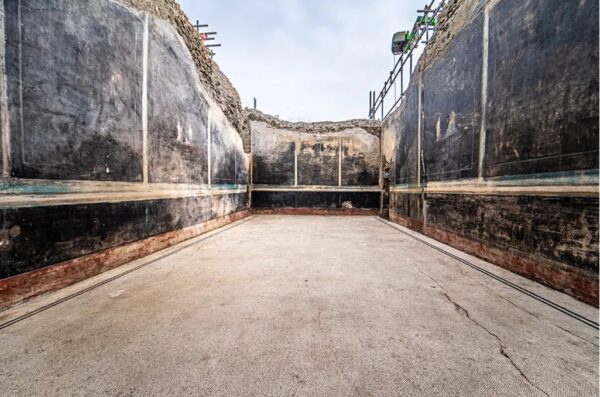
The room is floored in a geometric mosaic pattern comprised of at least a million tiny tiles, perhaps up to three million. On the walls are depictions of Paris’ abduction of Helen, which began the Trojan War; Zeus’ seduction of Leda, Helen’s mother, in the form of a swan; and Apollo’s attempted seduction of Kassandra, the Trojan princess sister of Paris, whom Apollo wooed with gifts of prophecy, only to curse her to never be believed, when she ultimately rejected his advances. The entranceway is dominated by a pair of gladiators surrounding an enormous phallus.
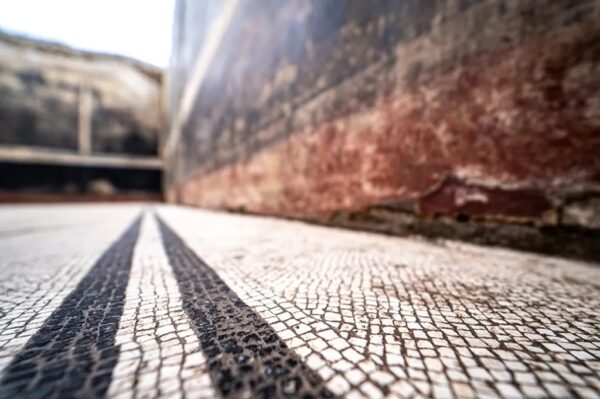
Work on uncovering Pompeii has been ongoing since the 1740s, with about a third of the city still to be excavated. The current dig, the largest in a generation, is overseen by Dr. Gabriel Zuchtriegel, Director of the Pompeii Archaeological Park, who made the presentation, assisted by park archaeologist Dr. Sophie Hay and chief restorer Dr. Roberta Prisco.
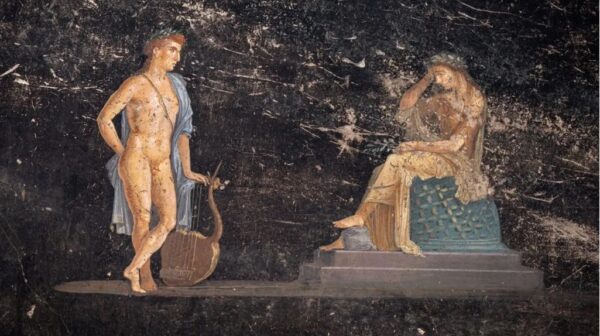
Intriguing as the discovery is, and as enthralling as the depictions are, surely such a mundane event cannot be portrayed in the stars, can it? Ummm, yeah, kinda.
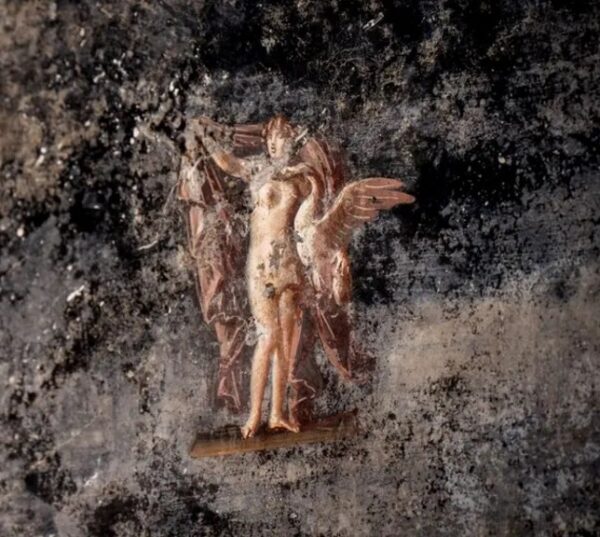
April 11th saw the exact conjunction of the Sun with a retrograde Mercury, at 22 Aries. The Sun provides the spotlight, Mercury in retrograde harks back to all things past, setting the stage generally for news (also Mercury) about something old (retrograde). In sextile from 21 Aquarius is asteroid Frescobaldi 11289, named for a seventeenth-century Italian composer, but standing in here for “fresco,” defining which old thing in particular would be highlighted (Sun) by this news story (Mercury).
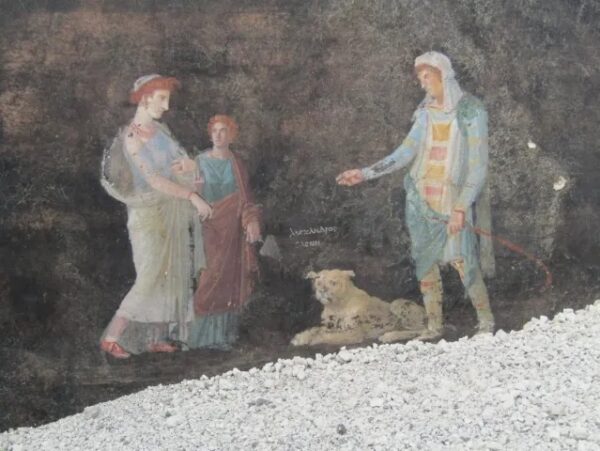
Saturn is the planetary energy we most associate with old or aged items. At 14 Pisces, Saturn conjoins asteroid Pompeja 203 (Italian spelling of Pompeii) at 19 Pisces. Sandwiched between them is Mars at 15 Pisces, which, as the ruler of all things sexual, represents the overall theme of the newly-revealed Black Room, whose frescoes include the seduction of Leda, abduction of Helen, attempted seduction of Kassandra, and the huge phallic image. Gladiators, as armed combatants, also fall under Mars’ rubric.
Not bad for a start, but the cosmos can do much better than that!
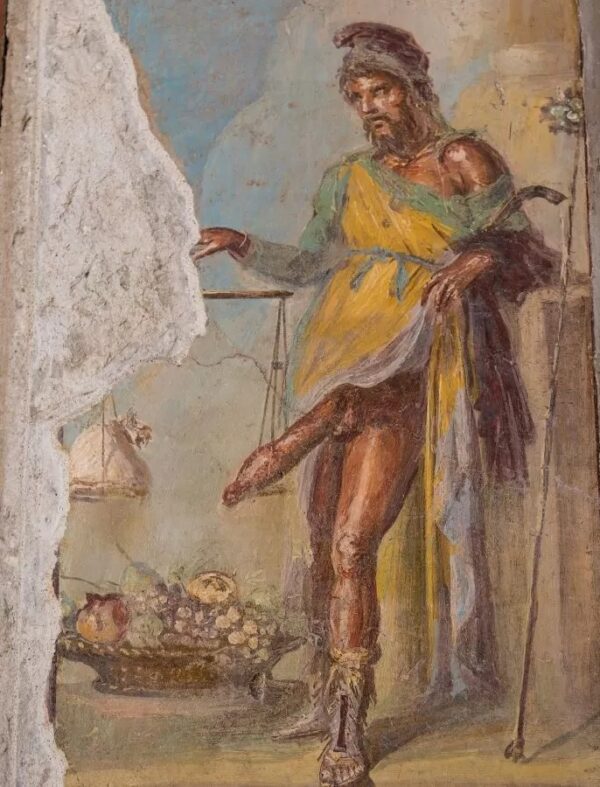
Like the name of the banquet room itself, the Black Room. How about asteroid Black 11204 at 13 Cancer exactly opposed asteroid Hall 3299 (the room’s purpose was a banquet hall) at 13 Capricorn, in a T-Square with Venus at 7 Aries, ruling art and artists (as well as entertaining, such as might occur in a banquet hall). With Black we see asteroids Photographica 443 and Apollo 1862, both at 14 Cancer, for the released photos and the figure of Apollo on the walls. With Hall we see asteroid Ceres 1 at 18 Capricorn, noted for a connection to nutrition and foodstuffs (for the banquet hall’s purpose) and asteroid Swann 4082 at 4 Capricorn, an alternate spelling of the guise Zeus is depicted in as he ravages Leda. With Venus herself we see asteroid Paris 3317 at 8 Aries, another mythic figure portrayed, and asteroid Pecker 1629 at 13 Aries, a common penis euphemism representing the enormous phallic image (of which, sadly, no pictures were released).

The size of that image is hinted at by asteroid Dong 150520, another penis euphemism, which at 3 Libra is sesquiquadrate Jupiter at 19 Taurus, ruling all things oversized and larger-than-life. And the image itself, as well as the preponderance of sexual themes, is also represented in two more penis euphemism asteroids: Wiener 18182 at 4 Pisces, semisquare the Sun/Mercury conjunction; and Dick 17458, opposed it from 27 Libra.

The remaining mythic figures also feature prominently on the day, boosted by connections to major planetary energies. These include asteroid Kassandra 114, which at 0 Aquarius closely conjoins Pluto at 1 Aquarius, noted for rape (and also ruling archeology, as a largely subterranean activity); asteroid Leda 38 at 13 Leo, in trine to both the Sun and Venus (denoting Zeus’ amorous – if avian – advances); and asteroid Helena 101 (for Helen of Troy), which at 16 Leo is trine the Sun and embedded at station (turning direct just five days prior).
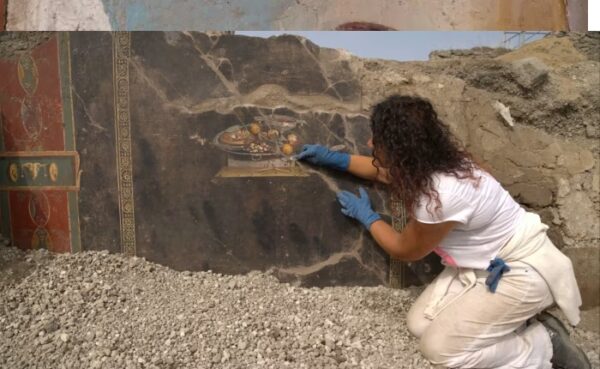
Even the Park staff gets in on the celestial act! Director Gabriel Zuchtriegel, chief mouthpiece for the reveal, is seen as asteroid Gabriella 355 (feminine equivalent) at 25 Capricorn, squared the spotlighting Sun and spokesman Mercury. Archeologist Sophie Hay, who explains the frescoes, appears as asteroid Sophia 251 (alternate form), opposed Saturn/Mars/Pompeja from 20 Virgo; and asteroid Hay 3125, at station from 26 Leo (turning direct April 2nd) and opposed Frescobaldi. Chief restorer Roberta Prisco, providing details about the Black Room’s recovery, attends as asteroid Roberta 335, which at 29 Capricorn conjoins colleague Gabriella and also squares Sun/Mercury; and as asteroid Priscio 78252 (closest to Prisco), exactly conjunct asteroid Hall, exactly opposed asteroid Black.

Not to be outdone, and seeking his due acknowledgment, Mount Vesuvius, unwitting preserver of all this historical bounty and artistic beauty, appears as asteroid Vesuvius 13897, which at 8 Leo is also at station (turning direct April 3rd), denoting his ultimate pivotal role in the story, trine Venus.
It just goes to show you, whoever or whatever you are or represent, whatever you’re doing, wherever you are, there’s an asteroid for that!


3 comments, add yours.
Laurien
Wow, it is a weird and wonderful universe we live in. By the way, you were probably trying to be delicate and not point out that Priapus was weighing his penis on a set of scales, so I decided I would. I guess the Libra placements are behind that. They must have been a lot less prudish in Pompeii than we are now!
greg
Could you investigate the Case of the Putney Pusher, Alex. To this day it remains unsolved.
Charlotte
Wow Alex, it seems I need to go back to Pompeii and take a squizz at what’s been going on there!
Seeing that the last time I was there was at the end of 1970, people were a lot more shy than they are now! I didn’t get to see a single penis (darn, I thought the 70’s were so permissive?).
A scruffy-ish guy called my fiance aside, and for a fairly large sum of money offered him a small box of slides. Of course each slide was tiny, so on taking a quick look thru them, all he could make out were a whole lot of flesh-coloured reclining women lolling around. When we got a closer look at them later, they turned out to be a set of reproductions of paintings (think Rubens) that were nowhere NEAR the age of Pompeii.
Still, they were quite good quality and also illustrated an amusing story about the gullibility of some young tourists. I think I still have them somewhere. With my strongly plutonic chart, I tend to hold onto things forever and ever and ever.